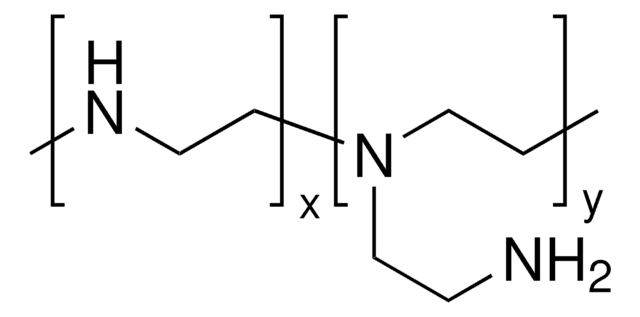Kluczowe dokumenty
482595
Poly(ethyleneimine) solution
average Mn ~1,200, average Mw ~1300 by LS, 50 wt. % in H2O
Synonim(y):
Ethyleneimine polymer solution, PEI
About This Item
Polecane produkty
masa cząsteczkowa
average Mn ~1,200
average Mw ~1300 by LS
Poziom jakości
stężenie
50 wt. % in H2O
współczynnik refrakcji
n20/D 1.454
lepkość
200-500 cP(25 °C)(lit.)
gęstość
1.08 g/mL at 25 °C
ciąg SMILES
N1CC1
InChI
1S/C2H5N/c1-2-3-1/h3H,1-2H2
Klucz InChI
NOWKCMXCCJGMRR-UHFFFAOYSA-N
Szukasz podobnych produktów? Odwiedź Przewodnik dotyczący porównywania produktów
Powiązane kategorie
Opis ogólny
Zastosowanie
Hasło ostrzegawcze
Warning
Zwroty wskazujące rodzaj zagrożenia
Zwroty wskazujące środki ostrożności
Klasyfikacja zagrożeń
Aquatic Chronic 2 - Skin Sens. 1
Kod klasy składowania
10 - Combustible liquids
Klasa zagrożenia wodnego (WGK)
WGK 2
Wybierz jedną z najnowszych wersji:
Masz już ten produkt?
Dokumenty związane z niedawno zakupionymi produktami zostały zamieszczone w Bibliotece dokumentów.
Klienci oglądali również te produkty
Produkty
New methods for materials fabrication at the micro- and nanoscale will drive scientific and technological advances in areas of materials science, chemistry, physics, and biology. The broad diversity of potentially relevant materials, length scales, and architectures underscores the need for flexible patterning approaches. One important example is the fabrication of 3D periodic structures composed of colloidal, polymeric, or semiconductor5 materials.
Gene therapy has become one of the most discussed techniques in biomedical research in recent years.
Professor Yoshiki Katayama (Kyushu University, Japan) discusses recent advances in drug delivery systems and strategies that exploit the EPR effect, with a special focus on stimuli-responsive systems based on novel materials.
Terapia genowa stała się jedną z najczęściej dyskutowanych technik w badaniach biomedycznych w ostatnich latach.
Global Trade Item Number
| SKU | GTIN |
|---|---|
| 482595-100ML | 4061832389585 |
| 482595-250ML | 4061832389592 |
Nasz zespół naukowców ma doświadczenie we wszystkich obszarach badań, w tym w naukach przyrodniczych, materiałoznawstwie, syntezie chemicznej, chromatografii, analityce i wielu innych dziedzinach.
Skontaktuj się z zespołem ds. pomocy technicznej




![[2-(Methacryloyloxy)ethyl]dimethyl-(3-sulfopropyl)ammonium hydroxide 95%](/deepweb/assets/sigmaaldrich/product/structures/217/219/73c91e1c-0ee4-4b3d-bead-a6dc3d09d1da/640/73c91e1c-0ee4-4b3d-bead-a6dc3d09d1da.png)





